Themed collection Database Analysis

Identifying intermolecular atom⋯atom interactions that are not just bonding but also competitive
This highlight criticises the QTAIM method and discusses algorithms for identifying intermolecular interactions that are both bonding and competitive.
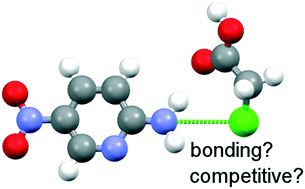
CrystEngComm, 2020,22, 7145-7151
https://doi.org/10.1039/D0CE00270D
Progress on cocrystallization of poorly soluble NME's in the last decade
Cocrystallization of pharmaceuticals has been an exciting field of interest to both academia and industries, demonstrated from its increasing growth rate of publications, patents, and marketed formulations.
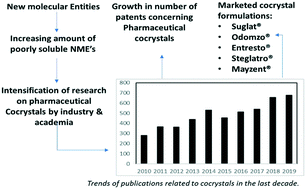
CrystEngComm, 2020,22, 6958-6974
https://doi.org/10.1039/D0CE01276A
First global analysis of the GSK database of small molecule crystal structures
Analysis of the molecular and structural features of the GSK crystal structure database and Cambridge Structural Database leads to improved reliability in hydrogen bond propensity models for pharmaceutical polymorphs.

CrystEngComm, 2021,23, 5430-5442
https://doi.org/10.1039/D1CE00665G
Regulating the distortion degree of the square antiprism coordination geometry in Dy–Na single ion magnets
A DyNa complex (1) and a DyNa2 1D chain (2) have been obtained; their square antiprism coordination geometries were changed from the bicapped triangular prism of the reported DyNa2 complex. Compounds 1 and 2 exhibit single ion magnet behavior.
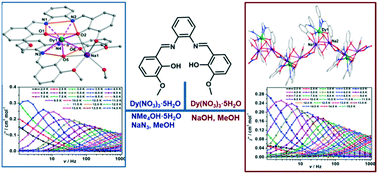
CrystEngComm, 2021,23, 3175-3184
https://doi.org/10.1039/D1CE00146A
Characterization of defect levels in β-Ga2O3 single crystals doped with tantalum
Optical properties and defect characterization of Ta-doped β-Ga2O3 single crystals grown by the optical floating zone method.

CrystEngComm, 2021,23, 2835-2841
https://doi.org/10.1039/D0CE01639J
Molecular engineering of carbazole–acrylonitrile fluorophores: substituent-dependent optical properties and mechanochromism
Controlling the fluorescence properties of organic molecules in the aggregation state and understanding the structure–activity relationship are important for developing excellent luminophors with tunable solid emission.
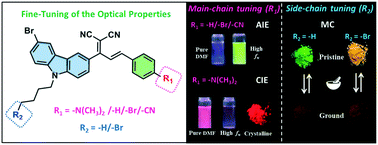
CrystEngComm, 2021,23, 2289-2296
https://doi.org/10.1039/D1CE00012H
Light illumination and temperature-induced current–voltage hysteresis in single-crystal perovskite photodiodes
Recently, current–voltage (IV) hysteresis, which is more frequently observed in thin film perovskite solar cells, has been intensively studied due to the destruction of data accuracy in device measurement.

CrystEngComm, 2021,23, 1663-1670
https://doi.org/10.1039/D0CE01676D
Organic solvates in the Cambridge Structural Database
Data informatics methods applied to the Cambridge Structural Database reveal shifting trends in solvate formation and inherent biases in the symmetry and packing fraction of solvates and their solvent-free analogues.
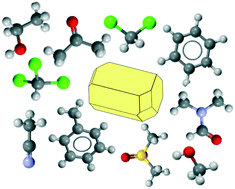
CrystEngComm, 2021,23, 1555-1565
https://doi.org/10.1039/D0CE01749C
Design of size-controlled Au nanoparticles loaded on the surface of ZnO for ethanol detection
Schematic diagram of the reaction mechanism of the sensor in air and ethanol.
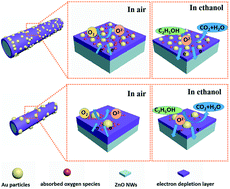
CrystEngComm, 2021,23, 783-792
https://doi.org/10.1039/D0CE01318H
Systematic screening for k type phase transitions – general approach and positive example for a binuclear Cu(II) paddlewheel structure
How to screen for k type phase transitions? Pseudo symmetry in reciprocal space represents a successful answer.

CrystEngComm, 2021,23, 841-849
https://doi.org/10.1039/D0CE01559H
High dual-state blue emission of a functionalized pyrazoline derivative for picric acid detection
High dual-state blue emission of a functionalized pyrazoline derivative for picric acid detection.
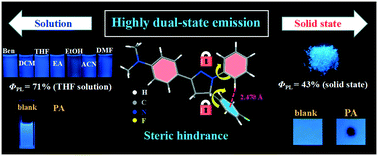
CrystEngComm, 2021,23, 221-226
https://doi.org/10.1039/D0CE01195A
Fast energy minimization of the CCDC drug-subset structures by molecule-in-cluster computations allows independent structure validation and model completion
Optimizing structures with computations on clusters of molecules permits generation of structure-specific restraints for refinement and structure validation.
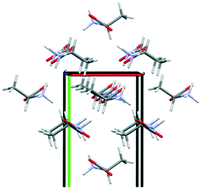
CrystEngComm, 2020,22, 7420-7431
https://doi.org/10.1039/D0CE00488J
Ring stacking and laddering in ammonium carboxylate salts: extension to secondary ammonium salts
A combined CSD and experimental study shows that the ring stacking and laddering principle, an ionic model, gives insight into the crystal structures of secondary ammonium carboxylate salts.

CrystEngComm, 2020,22, 7399-7406
https://doi.org/10.1039/D0CE00616E
Kryptoracemic compound hunting and frequency in the Cambridge Structural Database
Determination of kryptoracemic compound frequency in the Cambridge Structural Database using CCDC Python API script.
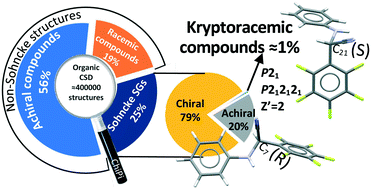
CrystEngComm, 2020,22, 7407-7419
https://doi.org/10.1039/D0CE00303D
Methods for easy recognition of isostructurality – lab jack-like crystal structures of halogenated 2-phenylbenzimidazoles
Easy recognition and numerical description of isostructurality; how different the similar structures can be; supramolecular aspects of isostructurality.
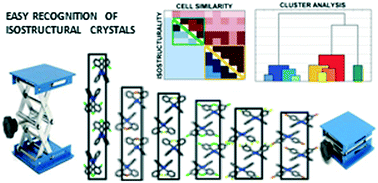
CrystEngComm, 2020,22, 7193-7203
https://doi.org/10.1039/D0CE00410C
Pseudosymmetric layers in high-Z′ and P1 structures of organic molecules
Layers having obvious approximate symmetry higher than that of the overall 3-D crystal are present in 20–25% of the Z′ > 4 and P1 organic structures archived in the Cambridge Structural Database. In some structures different types of layers alternate.
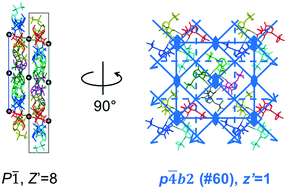
CrystEngComm, 2020,22, 7371-7379
https://doi.org/10.1039/D0CE00302F
Chirality and stereoisomerism of organic multicomponent crystals in the CSD
Multicomponent crystals in the CSD are classified into 49 subclasses based on chirality and residue type.

CrystEngComm, 2020,22, 7380-7388
https://doi.org/10.1039/D0CE00403K
Peculiarities of Br⋯Br bonding in crystal structures of polybromides and bromine solvates
Analysis of supramolecular associates formed by Br⋯Br interactions in crystals of 204 polybromide and bromine-containing compounds has been carried out.

CrystEngComm, 2020,22, 7361-7370
https://doi.org/10.1039/D0CE00288G
Data mining the Cambridge Structural Database for hydrate–anhydrate pairs with SMILES strings
A search method based on SMILES string matching was developed to identify hydrate–anhydrate structure pairs in the Cambridge Structure Database.
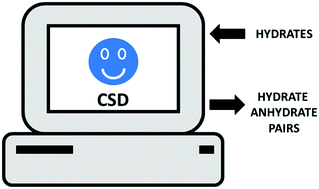
CrystEngComm, 2020,22, 7290-7297
https://doi.org/10.1039/D0CE00273A
The impact of the Cambridge Structural Database and the small molecule crystal structures it contains: a bibliographic and literature study
A bibliographic and literature-based analysis of the impact of the Cambridge Structural Database (CSD) and the papers associated with crystal structures in the CSD has been undertaken.
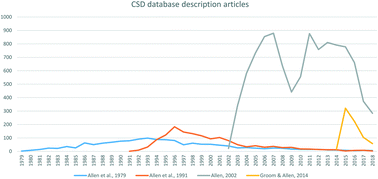
CrystEngComm, 2020,22, 7233-7241
https://doi.org/10.1039/D0CE00045K
Is it usual to be unusual? An investigation into molecular conformations in organic crystals
Molecular conformations can influence the structure and properties of crystalline solids.
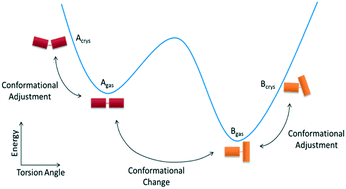
CrystEngComm, 2020,22, 7217-7228
https://doi.org/10.1039/C9CE02001B
The transition from 4f to 5d elements from the structural point of view
How structural properties reflect the transition from lanthanides to transition metals.
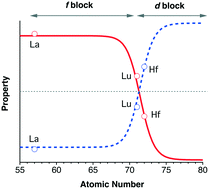
CrystEngComm, 2020,22, 7229-7232
https://doi.org/10.1039/D0CE00029A
Influence of rare earth elements (REEs) on the structure and optical properties of lithium zirconium phosphate (LZP)
The objective of presented study was to verify the concept of the formation of the REE–LZP solid solutions according to two different substitution models and to examine optical absorption properties of the samples for pigment application.
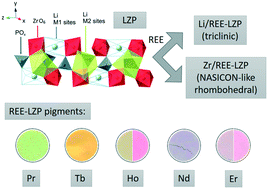
CrystEngComm, 2020,22, 5890-5899
https://doi.org/10.1039/D0CE00873G
Electron density based analysis of N–H⋯O![[double bond, length as m-dash]](https://www.rsc.org/images/entities/char_e001.gif) C hydrogen bonds and electrostatic interaction energies in high-resolution secondary protein structures: insights from quantum crystallographic approaches
C hydrogen bonds and electrostatic interaction energies in high-resolution secondary protein structures: insights from quantum crystallographic approaches
Limiting values of the topological parameters and the electrostatic interaction energies to establish the presence of true N–H⋯O![[double bond, length as m-dash]](https://www.rsc.org/images/entities/char_e001.gif) C H-bonds in protein main-chain have been identified using quantitative and qualitative analyses of electron densities.
C H-bonds in protein main-chain have been identified using quantitative and qualitative analyses of electron densities.
![Graphical abstract: Electron density based analysis of N–H⋯O [[double bond, length as m-dash]] C hydrogen bonds and electrostatic interaction energies in high-resolution secondary protein structures: insights from quantum crystallographic approaches](/en/Image/Get?imageInfo.ImageType=GA&imageInfo.ImageIdentifier.ManuscriptID=D0CE00577K&imageInfo.ImageIdentifier.Year=2020)
CrystEngComm, 2020,22, 4363-4373
https://doi.org/10.1039/D0CE00577K
Strong stacking interactions at large horizontal displacements of tropylium and cyclooctatetraenide ligands of transition metal complexes: crystallographic and DFT study
Large offset stacking of tropylium and COT ligands, which is dominant in crystal structures, surpasses an energy of −3.0 kcal mol−1.
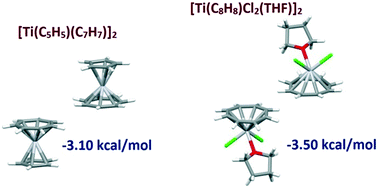
CrystEngComm, 2020,22, 3831-3839
https://doi.org/10.1039/D0CE00501K
A new Fourier transformation method for SAXS of polymer lamellar crystals
The interface distribution function is composed mainly of the self-interference item of the first interface F11, the interference term of the first and the second interfaces F12, and the interference term of the first and the third interfaces F13.
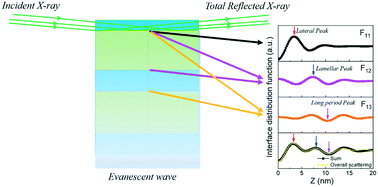
CrystEngComm, 2020,22, 3042-3058
https://doi.org/10.1039/D0CE00157K
Existence of untypical halogen-involving interactions in crystal packings: a statistical and first-principles study
There is a common perception by the scientific community that a halogen-involving interaction forms when the distance between the donor atom and the acceptor atom is less than the sum of their van der Waals (vdW) radii.
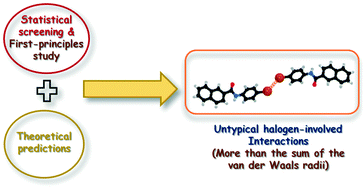
CrystEngComm, 2020,22, 2756-2765
https://doi.org/10.1039/C9CE01885A
The isothermal decomposition of a CL-20/HMX co-crystal explosive
The isothermal decomposition process of CL-20/HMX co-crystals was studied through an isothermal decomposition dynamics research method.
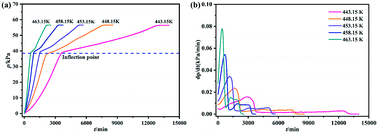
CrystEngComm, 2020,22, 1473-1479
https://doi.org/10.1039/C9CE01850F
About this collection
The latest research on Database Analysis published in CrystEngComm.